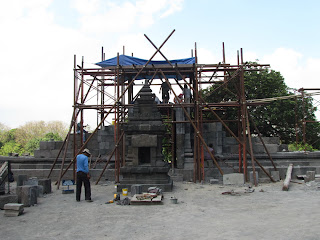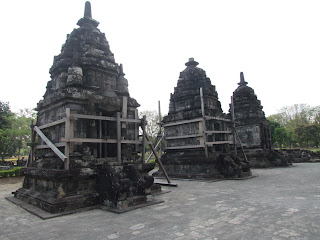Yogyakarta has two fine examples of religious temples that are nearby. One is the Buddhist temple of Borobudur. The other is the Hindu complex of Prambanan. And Prambanan is apparently the largest Hindu complex in southeast Asia. I'll take their word for it, but I recall there being some Hindu aspect to the temples of Angkor and they are much larger. Perhaps I am mistaken though. In any case, the Prambanan complex is located at the end of one of the city bus lines of Yogyakarta. (Although it is not called a busway, it operates in exactly the same way as the busway system of Jakarta.) Early on my first morning in Yogyakarta, I debated whether I would go to Prembanan or to Borobudur first. I opted for Prembanan because it was just a bit easier to manage. I headed to the bus stop and caught the appropriate bus and off I went. About an hour later, I arrived at the bus terminal and was accosted by touts wanting to drive me to the gate. When I said I would walk, they seemed aghast. “But it's a kilometer!” And? Are there crocodiles blocking the way? Will I have to duel with a sword to gain passage without someone to take me there safely? What? I guess all the tourists who fly in for a day tour from parts unknown, who have all kinds of money, and who can't seem to do anything for themselves (because they never seem to) give some kind of we-foreigners-are-helpless-and-pampered kind of impression because it's like a foreign concept that a foreign visitor, who has already managed to get himself almost to the site on the public transport system, still is going to want to take a ride a few hundred meters to the entrance of the site he/she has come to see. I don't exactly begrudge people their money and how they use it, but I wish they wouldn't add to the pampered and money-is-no-object idea that the people of poorer nations often have of us. Or that I wouldn't rather have the experience of getting someplace on my own, on the bus, walking, however it may be. Anyhow...
 As I was walking to the entrance area, I passed outside the gated area and had a nice view from outside.
As I was walking to the entrance area, I passed outside the gated area and had a nice view from outside.I hoofed it to the ticket office, the please-go-here-foreign-visitors ticket office. Now I know that in a country like this, it's impossible to charge everyone the money it takes to protect a site like this. The price is too high and if they were to charge the same price to the local people, the local people wouldn't be able to afford to come and visit it. And the site is their cultural heritage. They ought to be able to come and visit it. I don't know exactly what the locals pay to come and see the Prambanan complex, but I do know it must be significantly less than the 117 000 Rupiah that foreigners pay. (That comes to about 13 dollars, so it is not outrageous and I don't begrudge paying that price so that a site can be protected and rehabilitated.) But... I felt a bit patronised by going into a nice, air conditioned ticket office where there was “free” tea and coffee, and probably a nice bathroom. I know I'm paying more. And they know I'm paying more. Perhaps they don't understand that I know I am paying more. But we all know why I am paying more. And if they are really putting any of the extra money that I am paying into electricity for air conditioning, coffee and tea, and a nice bathroom, instead of into the preservation of the religious site, then I don't want to pay more.
Okay enough sour grapes. I went into the site. It's quite amazing. There are actually four temples on the grounds of the complex. Prambanan is the largest. The Hindu religion has numerous gods. The three chief gods are Brahma, Shiva, and Vishnu. Brahma is the father of the world, Shiva is the destroyer, and Vishnu is the protector. (I think. My knowledge of Hinduism is getting a bit old and I didn't spring for the tour guide to show me around.) The Prambanan compound has three main temples, one for each of the three main gods. There are also three lesser temples for three of the lesser gods. (Ganesha was one of those.) Now unfortunately in 2006, there was an earthquake that was centered pretty much under Yogyakarta and the Prembanan complex. Much of the site was damaged and restoration efforts are on-going. Nevertheless it is an impressive view.
 Because of the earthquake damage, many of the surrounding structures have had to have been taken apart. The whole process is detailed on signs nearby. They went and took photos of the structures. They measured it. They marked each stone for its place in the structure and then took the structures to pieces to be reassembled at a later time during the restoration process. These are all disassembled stupas that had sat around the Prambanan compound.
Because of the earthquake damage, many of the surrounding structures have had to have been taken apart. The whole process is detailed on signs nearby. They went and took photos of the structures. They measured it. They marked each stone for its place in the structure and then took the structures to pieces to be reassembled at a later time during the restoration process. These are all disassembled stupas that had sat around the Prambanan compound.This is in addition to all the damage that the years and years of use and erosion have wrought. Some blocks have been replaced, but the designs that were carved on them have been lost. It's a shame because the carving must have been exquisite. And even though I can't really tell for sure which is original work and which is restored or replaced work, it seems it must have quite impressive when it was originally done.
 She and her family had hired a guide. I heard her say a couple of times, “Wow!” But I'm not really sure she meant it.
She and her family had hired a guide. I heard her say a couple of times, “Wow!” But I'm not really sure she meant it.I think this one was Vishnu.
I liked how the profile was lit from the light coming in the door.
Nearby, there were three other smaller temples. The first was quite small, Lumbung Temple. It was Buddhist. The other temples were not Hindu, and must have been examples of the two religions co-existing peacefully. This temple had been damaged quite heavily.
The last temple was Sewu Temple. It was a much larger Buddhist temple. It is actually second in size only to Borobudur of the Buddhist temples of Java.
 It also seemed to have suffered a fair amount of damage during the earthquake, but is undergoing restoration.
It also seemed to have suffered a fair amount of damage during the earthquake, but is undergoing restoration.After visiting the four temples, it was a quick visit to the on-site museum and then a return to Yogyakarta after a successful jaunt to the edge of town.













No comments:
Post a Comment